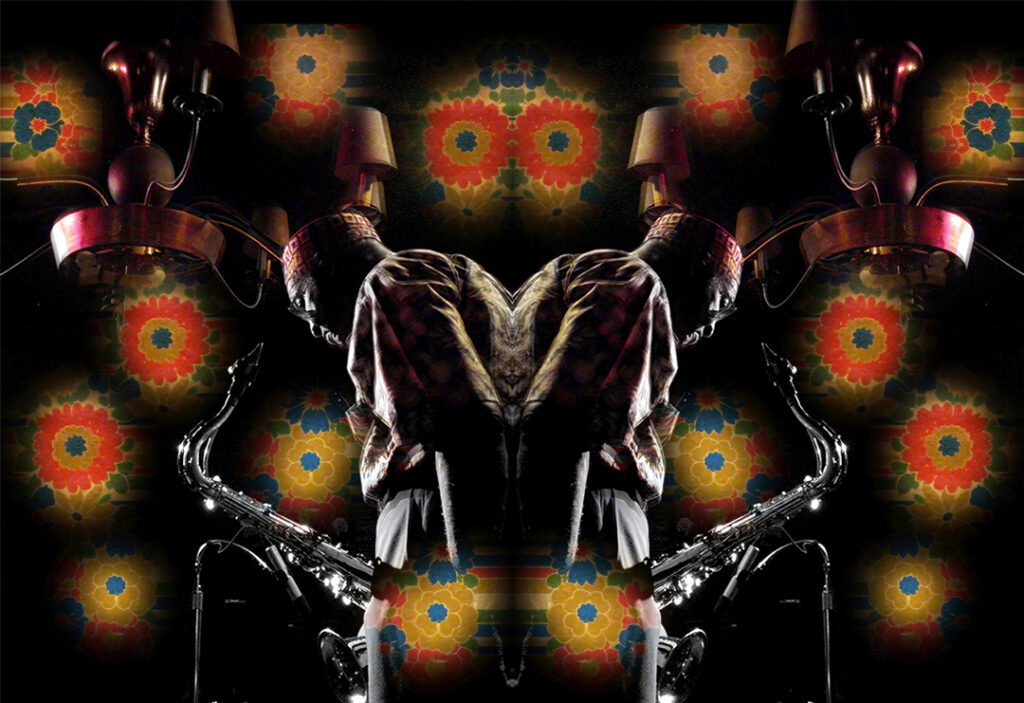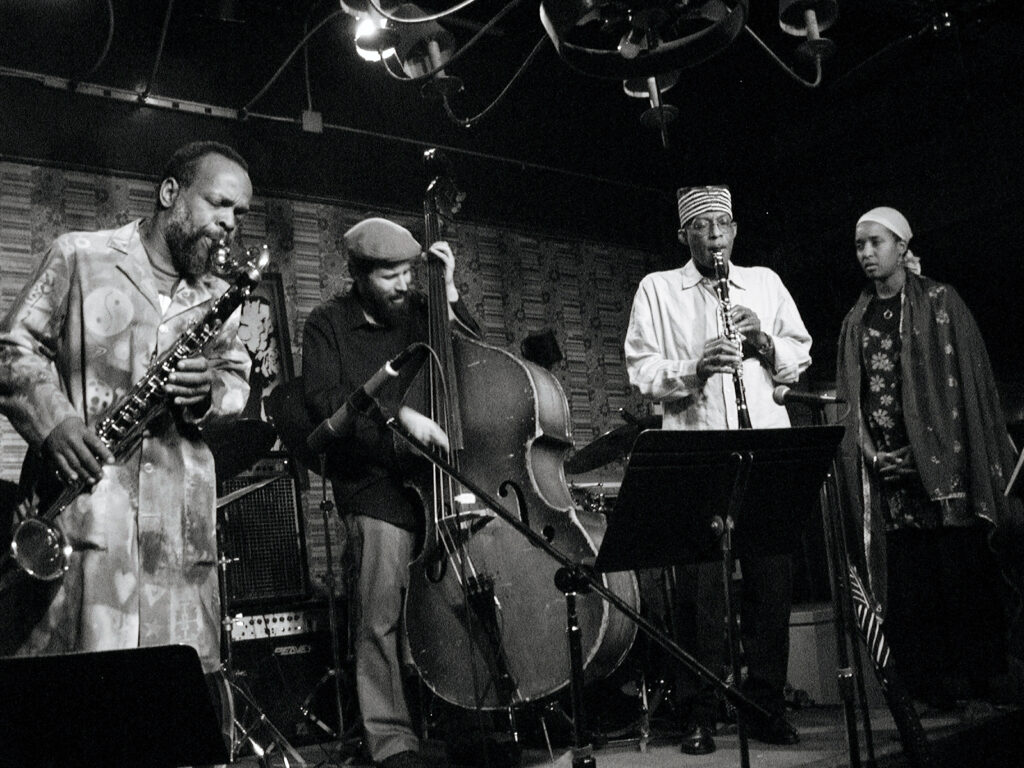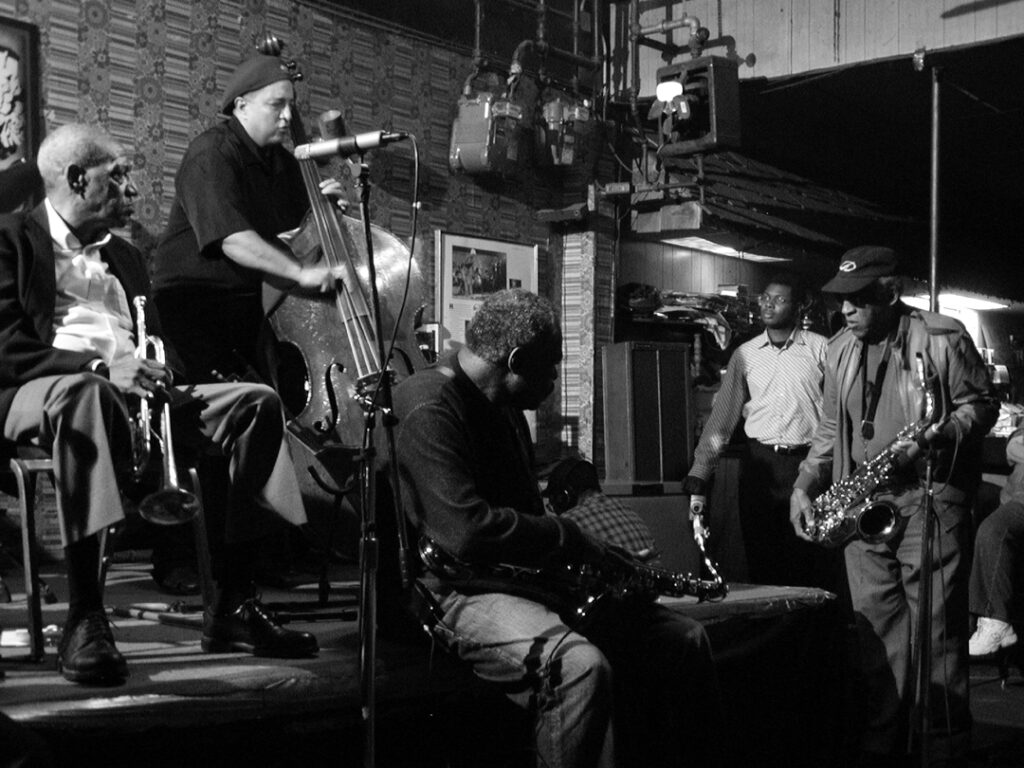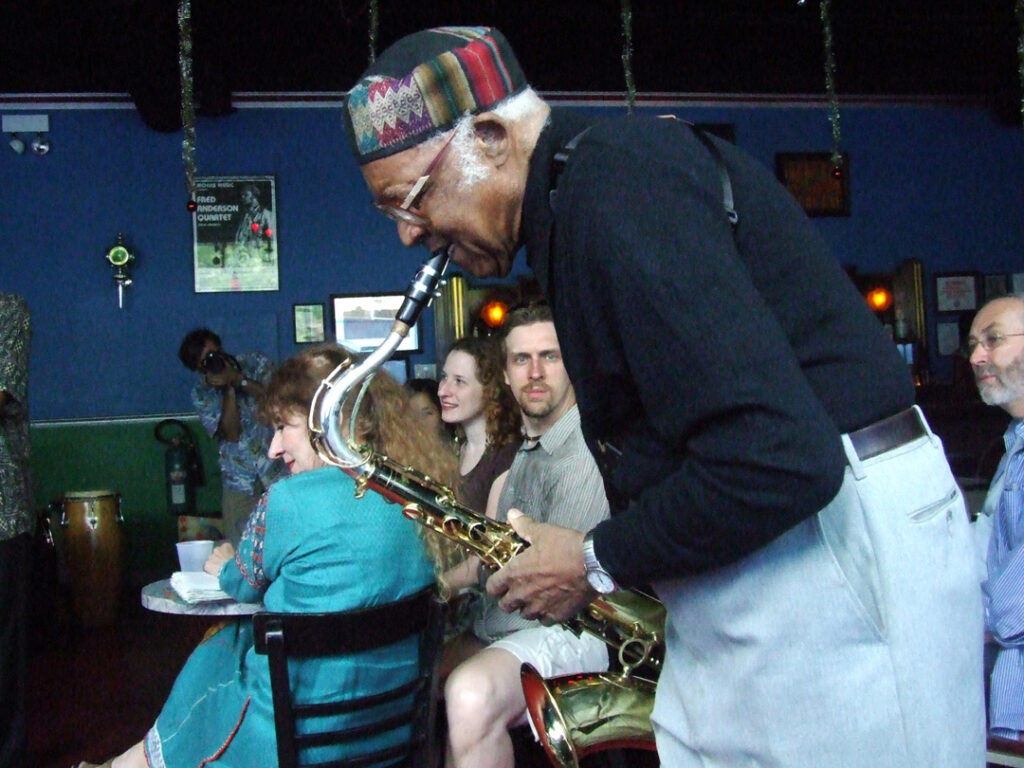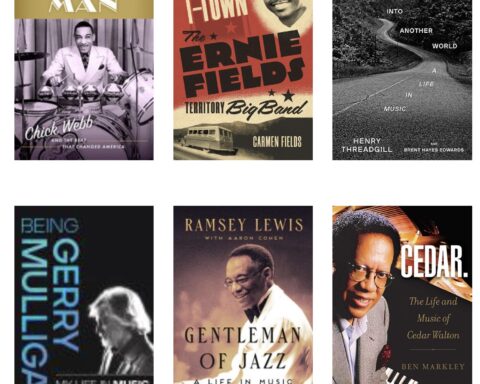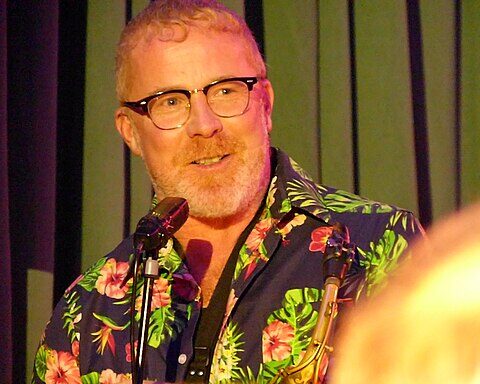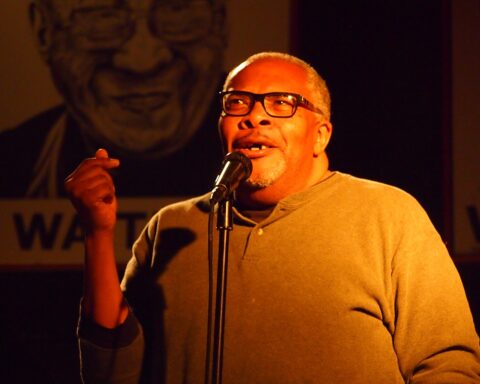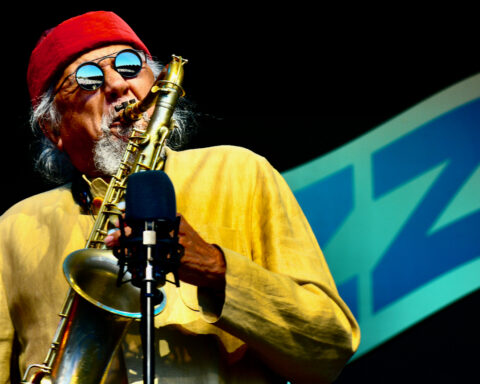Ethereal ensemble expressions – starting with the guimbri, a three-string bass from North Africa, soon enhanced by tenor saxophone, meditative chant, frame drum, acoustic bass, and electric guitar — reached the ears of everyone entering the Logan Center Screening Room at the University of Chicago.
The music was “From the River to the Ocean” by tenor saxophonist Fred Anderson (1929-2010) and his local collaborators, on a loop as a soundtrack for the slideshow onscreen stage-center during the multi-media presentation “Velvet Lounge 40 Years Later: A Legacy of Place,” at last September’s Hyde Park Jazz Festival.
Despite its demise as a creative music oasis in 2012, the Velvet Lounge’s forever imprint, and the open, honest humility and artist acceptance by Anderson, its patriarch, are still being cherished by performers and patrons everywhere. “Velvet Lounge 40 Years Later: A Legacy of Place” featured a panel of bassist Tatsu Aoki, Velvet handyman and Anderson assistant Andy Pierce, drummers Avreeayl Ra and Isaiah Spencer, and Velvet bartender Donna Joy Wolfe. Four photographers — Lauren Deutsch, Marc PoKempner, Michael Jackson, and Mark Sheldon (all, incidentally, active JJA members) — contributed images to enhance the event.
The slideshow* began with PoKempner’s black-and-white photos outside the Velvet’s original location, 2128 ½ South Indiana Avenue, and concluded with Deutsch’s photo montage featuring Anderson, the club’s patriarch. Images of Ernest Dawkins, Ken Vandermark, Nicole Mitchell, Henry Grimes, David Boykin, Von Freeman and numerous other expressionists were also captured the four photographers.
At 4 p.m., the conversation began. Moderated by some dude* who resembles Idris Elba – minus the money, muscles, and movies – the first thought-prompt was: “What moment, at this moment, is foremost in your mind when someone says, ‘The Velvet Lounge’?”
Avreeayl Ra recalled when the Velvet’s clientele included community folks who enjoyed the space as a neighborhood tavern and a neighborhood tavern only. When Anderson began twice-monthly Sunday afternoon jam sessions, the regulars’ suspicions were aroused.
Once a four-dollar cover charge was implemented, “the community members were really salty about that,” Ra said. “Then the clientele turned over from community members to jazz fans and players.”
During these early transitional days, Ra added, he and saxophonist Ari Brown hosted Community Music Workshops on Thursdays. “From there, (the music bookings) went from Thursday to almost every night,” he said. “It was Ari, myself and (bassist) Fred Hopkins. When Fred got ill, we replaced him with Malachi Favors. And, at one time, it was Malachi and Rollo Radford, who was my bass mate in Sun Ra’s Arkestra. This is very meaningful to me when you start talking about the Velvet.”
For Tokyo-born Tatsu Aoki, performing Black-influenced, Asian-American creative music was spiritual mentorship. Chicago’s Asian-American creative musicians, he explained, were not accepted at other venues due to the city’s segregated scene (he also mentioned Fred Chicago Chamber Music, his album with Anderson and drummer Afifi Phillard, as a major accomplishment).
“The Velvet was much more than a place to play. It was okay for us to play who we are and okay to be who we are,” said Aoki, wh played along with Ra in Anderson’s trios and quartets. “We could do whatever we wanted. We would bring in taiko drums, and Avreeayl and I would play them; also, the horn and the shamisen. The Velvet was the only place [for us] during the late 90s’ to 2012.”
Isaiah Spencer described how he and his homeboys – trumpeters Maurice Brown and Corey Wilkes, keyboardist Justin Dillard and bassist Junius Paul – were able to find and hone their voices at the Velvet, where Anderson allowed everyone to explore.
“He never berated anyone,” Spencer began, “but he was also adamant that we understood the traditions and different trajectories that go along with the music and other ethnic music.”
When first asked by Anderson to lead the weekly jam sessions, Spencer hesitated. After additional encouragement from Fred – “Naw, man, I think you can do it. The cats dig you,” – he agreed, and led a house band which included saxophonist Matana Roberts, bassist Joshua Abrams, keyboardist Jim Baker and drummer Chad Taylor.
“That was my first gig as a bandleader,” said Spencer, whose groups have long since become featured at venues all over Chicago. “Being a bandleader and composer today, 20 years later, and working with youth, is what I do as an educator. If that moment [when I accepted the challenge] didn’t happen, I would not be on this stage doing what I do now.”
Spencer’s ensemble played the final gig at the original Velvet (he has a recording, and considers releasing it) and the first at its second, final location, 67 East Cermak Road. He had not known about that first distinction until receiving a call at home the day after the gig from Anderson, who said something serious had happened.
The roof had caved in. On his drums.
“Say, man, I think we got an accident,” Spencer recalled Anderson telling him. “ ‘I don’t know if anything is bent. All I see is a lot of white stuff.”
Spencer’s attention went from the Bears game he’d been watching to his gear. Anderson promised to reimburse him for damages, but this proved unnecessary. (The cave-in culprit is revealed below, hang on). Abstrakt Pulse, Spencer’s group with Paul, Wilkes, saxophonist Kevin Nabors and tap dancer (tapist?) Jumaane Taylor, opened the new Velvet.
“Fred could not charge, because he had not yet gotten his entertainment license. He could only get donations,” Spencer said. “In those first two nights, we made three grand. We gave Fred five hundred.”
When Sunday sessions at the original Velvet were led by trumpeter Billy Brimfield, Donna Joy Wolfe confronted the fears she experienced walking past the club and decided to venture in.
“It was so desolate and scary around there,” she recalled of the neighborhood, near railroad tracks and unsightly public housing complexes. But after meeting Anderson, Wolfe began vibing with Brimfield’s musicians, including drummer Ajaramu, bassist Louie Varro and Dudley Ammons, who, she said, “sang like Arthur Prysock.”
When break-time came, Brimfield began with questions for her: “Who are you? Where you come from? You married? You coming back?” she recalled. Wolfe returned regularly to those Sunday sessions, bringing along her good friend Debra Wyatt. Soon, both became the Velvet’s bartenders. “We had crazy fun with those guys,” Wolfe said.
“When I came to work at the Velvet, I had them all in one place,” she continued. “And now they’re everywhere. I see their names and smile. They’re doing fantastic stuff.”
Once Wolfe became a Velvet employee, she confronted something that threatened her last nerve: the women’s restroom. “Unacceptable!” she remembered, while forum attendees in the know laughed. “I brought some hand towels, so you didn’t have to pull down that pull-down thing that you didn’t know was ever clean. I think I even left a bowl of potpourri in there.”
Fred Anderson’s real focus, Andy Pierce began, involved paying every invoice so that the Velvet’s doors would remain open.
“He knew when that bill was going to hit the mailbox, and if it wasn’t there, he worried that he had lost it,” said Pierce, who has contributed numerous Anderson performance recordings to the Creative Audio Archive at the Experimental Sound Studio (on Chicago’s north side). “He went to great lengths to keep the Velvet square and subsidized it, too, with his gigs.”
Then, his lips and legs trembling in double time, Pierce admitted to being the cave-in culprit. On an oath, he testified that he and Clarence Bright, Velvet’s audio engineer, had fixed the roof because a tree, cut down during demolition done nearby, had poked holes in it.
“Several months later, the plaster dried out, so it eventually fell,” Pierce explained. “I told Fred, ‘We don’t have to close. We can fix this. Nobody will know.’ But Fred said, ‘No. We’re done. That’s it.’”
Jazz journalist John Litweiler, who joined the panel as the audience q&a began, likened the Velvet to an international jazz festival. Then, directly addressing the panel’s musicians, said: “I’m sure you’ve seen the world’s greatest jazz venues, the world’s greatest jazz cities, and I wonder if any place you’ve been can match the quality of the Velvet Lounge,” he said. “I’m just beyond flabbergasted that we had this right next door.”
Spencer added that the Velvet’s legacy is being preserved today by local venues like the Hungry Brain and Constellation.
“The actual bar from the Velvet is at Constellation,” he noted. “And the picture from the Velvet, of the African-American lady [Julie Nice] with the ‘fro and things showing, is there. Almost any place where there’s creative music, you can’t help but think of the Velvet Lounge and Fred Anderson.”
While Anderson’s legacy and openness nurtured artists from embryonic expressions to international presence, Velvet alumna Linda Marusarz Platt shared a story where limits were imposed. It happened during an AfterFest performance at the original location.
“Saxophonist Hanah Jon Taylor, who is very tall, was playing beneath the chandelier that he hit with his horn while he was playing, and he liked the effect,” she said. “And he kept bouncing it with his horn. Fred noted this, and said, ‘No!’ That’s the only time he did not allow freedom of expression.”
* Moderator’s real identity: Said dude is the author of this hit. Hope you dug it!)

